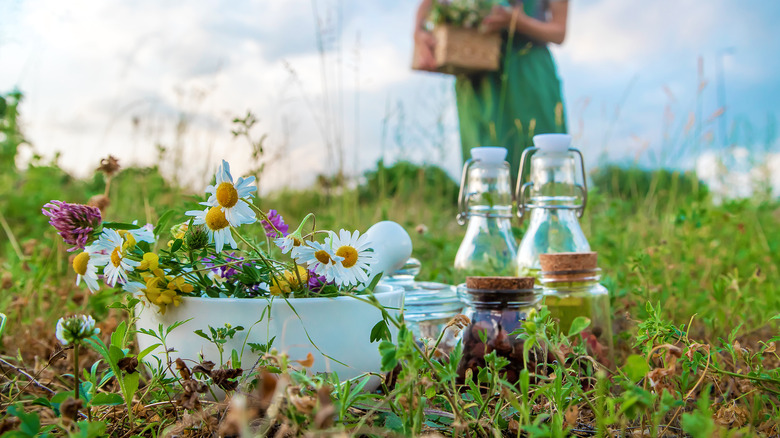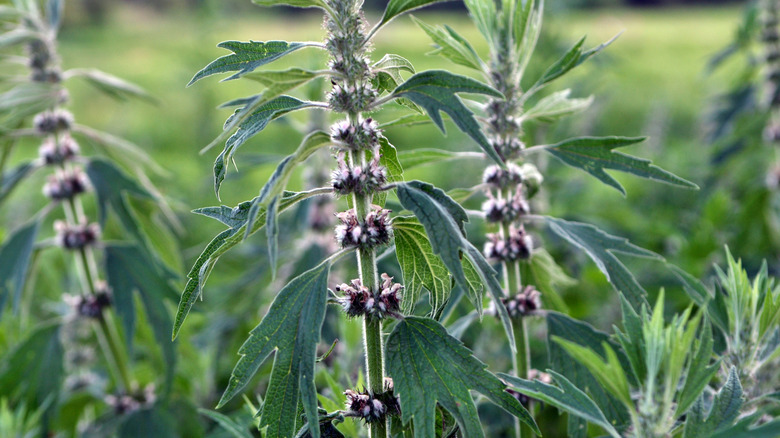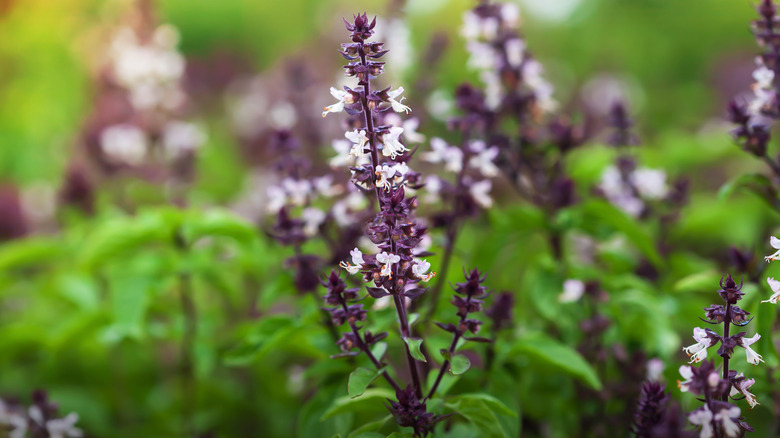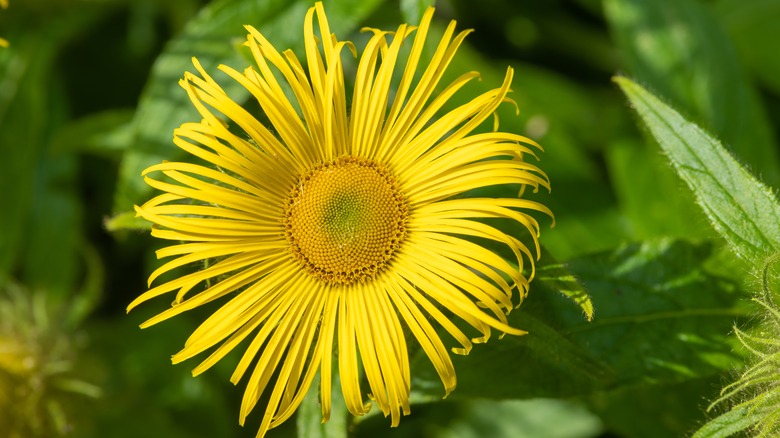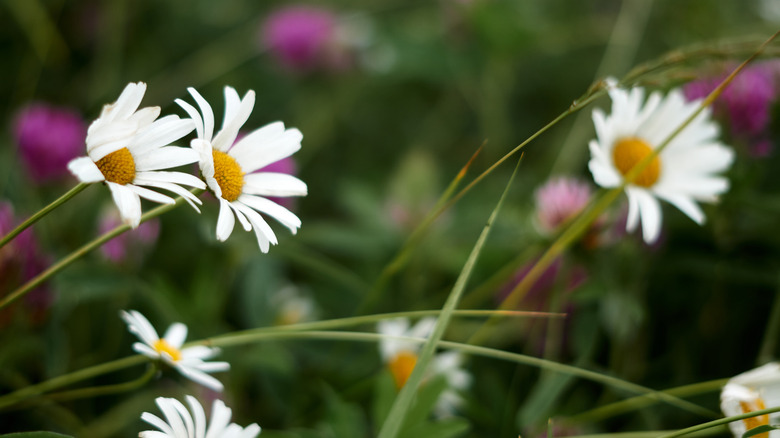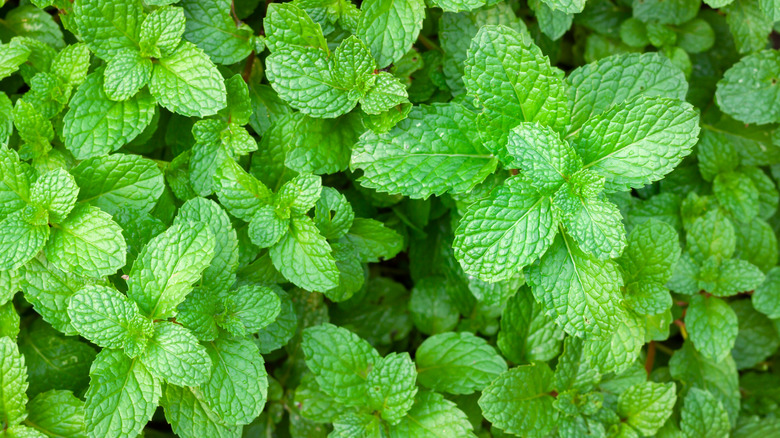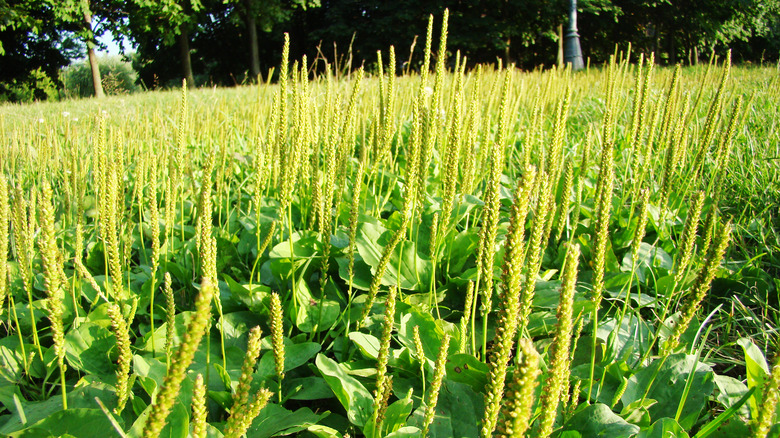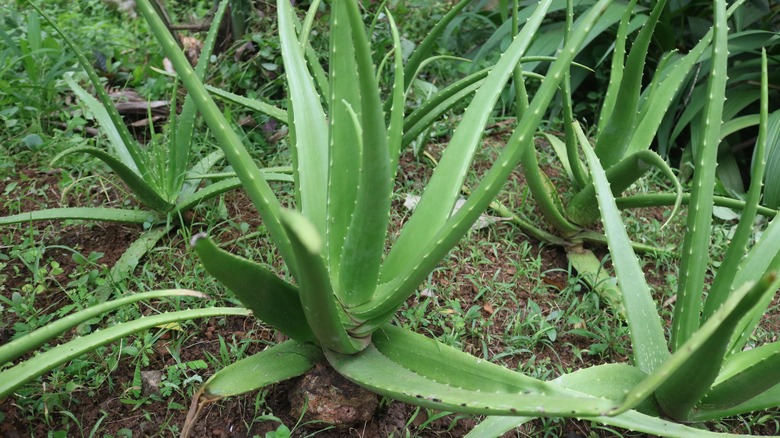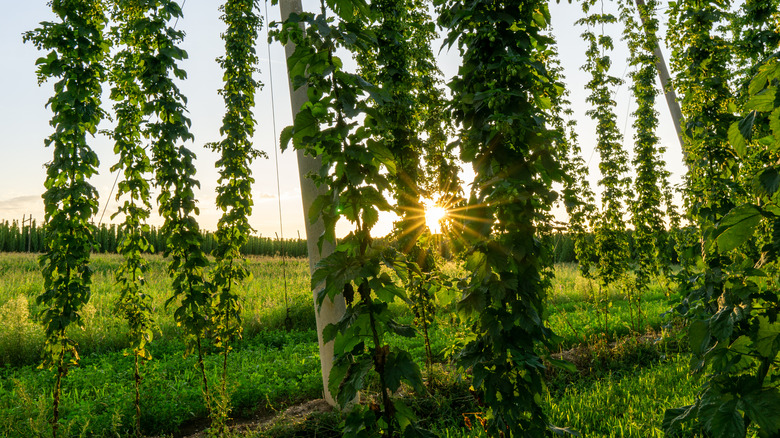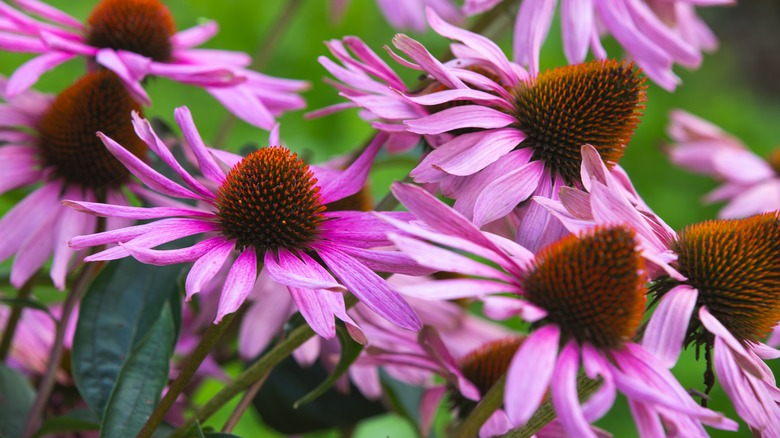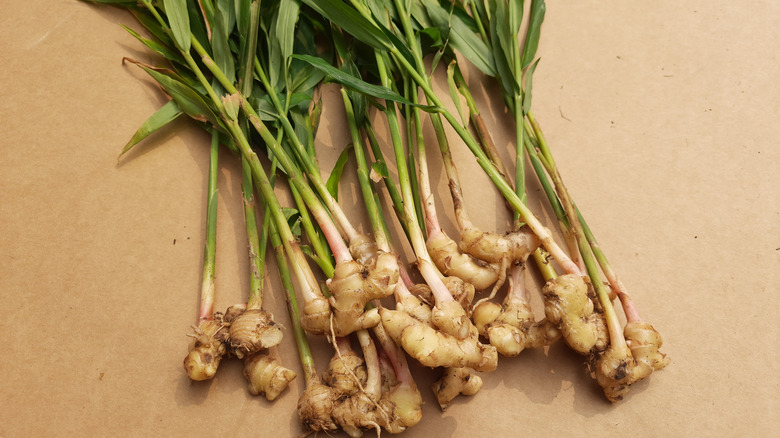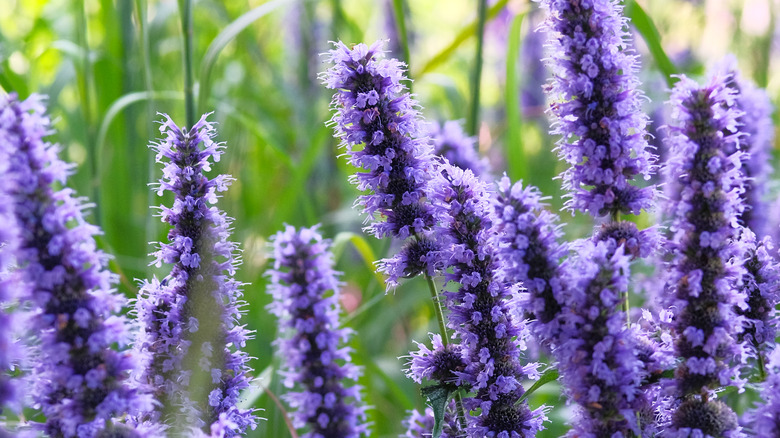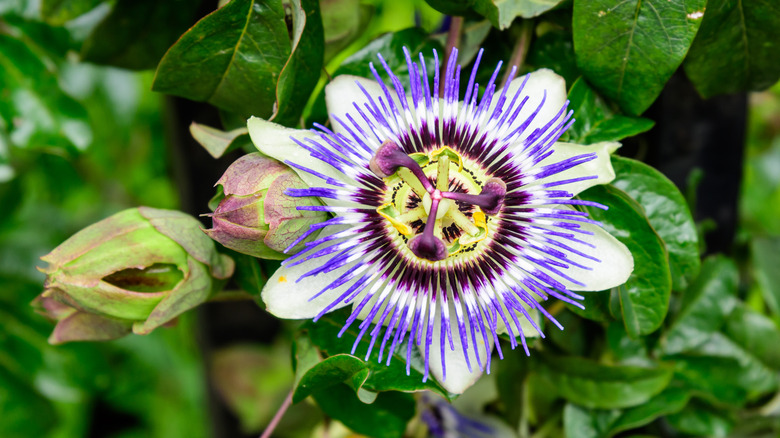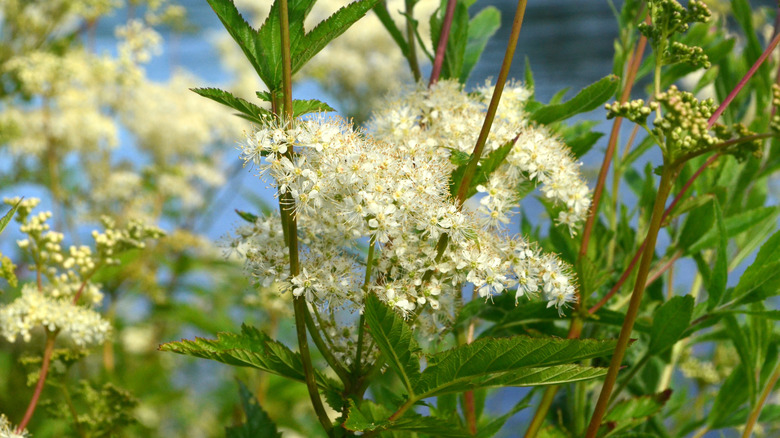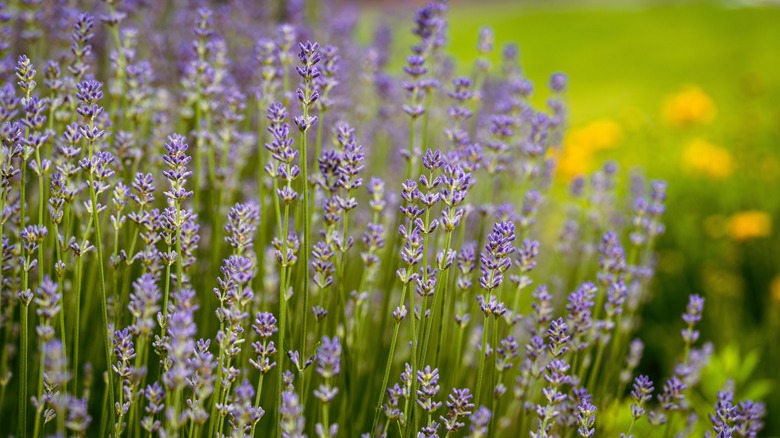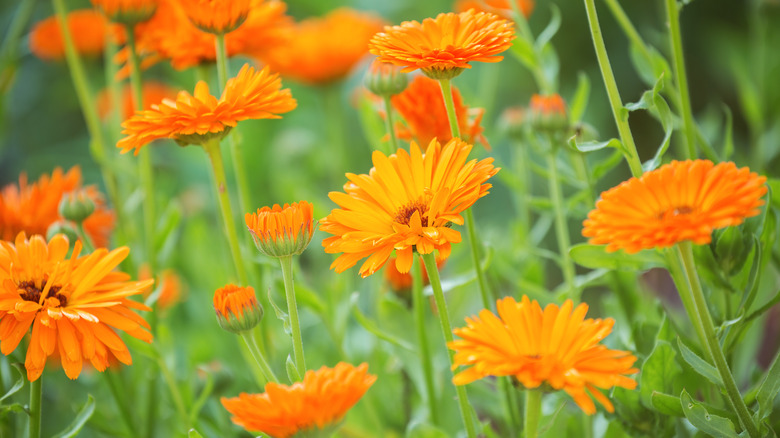15 Plants With Medicinal Properties You Can Grow In Your Garden
When you're feeling sick, not much feels better than a hot mug of tea to soothe your throat and provide you with some much-needed vitamins. However, you don't need to run to the store to buy an overpriced and over-processed box of tea. With a properly cared-for medicinal garden, you can create your own calming camomile, immunity-boosting echinacea, and asthma-treating hyssop tea, as explained by the New York Times. It doesn't end with herbal teas, though. You can grow many other beneficial plants such as ginger, aloe vera, and common plantain to try to naturally treat a wide range of ailments.
It goes without saying that most illnesses and injuries should be dealt with by a medical professional, and you should always contact your doctor before supplementing your diet with medicinal herbs. Still, when you know your way around a garden filled with the beneficial plants in this collection, you can manage the annoying or painful symptoms of some illnesses without going out to buy over-the-counter medicine and teas.
1. Motherwort
Motherwort (Leonurus cardiaca) is an herbaceous perennial native to a few countries in western Europe. It prefers slightly shady locations and moist soil along roadsides and woodland margins. The plant has a few medicinal applications, particularly in disorders often seen in women. According to the Missouri Botanical Garden, this is why it is commonly known as motherwort.
Bloom Season: Summer
USDA Growing Zone: 3 to 8
Growing Conditions: Partial shade
Soil Type: Moist and fertile
Size: 2 to 5 feet tall
2. Holy basil
Holy basil (Ocimum tenuiflorum), a relative of the common cooking ingredient great basil, has been referred to as a medicinal plant for many years. According to Washington College, it is frequently grown and harvested in southeast Asian countries, such as India, as a natural treatment for a range of ailments including eczema, bronchitis, stomach ulcers, indigestion, and insect bites.
Bloom Season: Seasonal blooms
USDA Growing Zone: 10 to 12
Growing Conditions: Full sun
Soil Type: Moist and well-draining
Size: 3 feet tall
3. Elecampane
Elecampane (Inula helenium), a flowering herbaceous perennial, is a tall-growing plant with many uses. The rhizomes and roots are used in medical applications by some herbalists. They are thought to treat several respiratory illnesses. As per the Missouri Botanical Garden, this plant is quite easy to grow in the garden as it has no serious disease problems or difficult care requirements.
Bloom Season: Summer and fall
USDA Growing Zone: 3 to 7
Growing Conditions: Full sun to partial shade
Soil Type: Moist and well-draining
Size: 3 to 6 feet tall and 2 to 3 feet wide
4. Chamomile
Chamomile (Matricaria chamomilla) has a long history of use in teas and some food dishes. This herb, which looks much like the common daisy, is a staple in most medicinal gardens due to its soothing properties. North Carolina State Extension mentions that the tea made from this flower is considered a sedative by many and is used for restful sleep.
Bloom Season: Summer and fall
USDA Growing Zone: 2 to 8
Growing Conditions: Full sun to partial shade
Soil Type: Well-draining
Size: 13 to 30 inches tall and 8 to 12 inches wide
5. Peppermint
Peppermint (Mentha x piperita) is an adaptable herb that grows well with several other plants in most gardens, though it spreads rapidly and aggressively, as warned by Missouri Botanical Garden. It can be used as ground cover or grown in a small pot depending on your harvesting needs. No matter where you grow it, however, its versatile nature makes it useful for natural remedies.
Bloom Season: Summer
USDA Growing Zone: 5 to 9
Growing Conditions: Full sun to partial shade
Soil Type: Rich and moist
Size: 1 to 2 feet tall and wide
6. Common plantain
The common plantain plant (Plantago major) can be identified by its long, elliptic leaves and insignificant purple flowers. The foliage of the plant is almost always green, however, it can show off some red. These leaves are what contribute to the plant's use in medicine. They may treat bites, stings, and cuts, as well as a few other ailments, as noted by the North Carolina State Extension.
Bloom Season: Spring to summer
USDA Growing Zone: 3 to 12
Growing Conditions: Full sun to partial shade
Soil Type: Moist and well-draining
Size: 4 to 16 inches tall
7. Aloe vera
Aloe (Aloe barbadensis) is a great succulent to grow alongside other warm-weather and drought-tolerant plants. Grown in the right conditions, aloe plants can become more than a foot tall. They provide gardeners with long, thick leaves filled with a gel that can be used to heal mild burns and cuts, as told by the University of Florida. Thankfully, they are extremely easy to grow and require little attention.
Bloom Season: Late winter to spring
USDA Growing Zone: 8 to 11
Growing Conditions: Full sun to partial shade
Soil Type: Well-draining potting media
Size: Up to 2 feet tall
8. Hops
Hops (Humulus lupulus) are known for their use in flavoring beer; however, they also have a long history of use in Chinese and other folk remedies, as said by the University of Michigan. This vining plant is quite beautiful whether you use it in your medicinal garden or not. It is covered in toothed leaves, green flowers, and fruit. Allow it to climb a trellis or grow it on a fence for more privacy.
Bloom Season: Summer
USDA Growing Zone: 4 to 8
Growing Conditions: Full sun to partial shade
Soil Type: Well-draining
Size: Up to 33 feet long
9. Purple coneflower
The purple coneflower (Echinacea purpurea) is an incredibly popular garden flower that many don't realize has medicinal properties. Echinacea species are known for their easy-to-grow habit and long-lasting blooms, states Clemson Cooperative Extension. However, the flowers, leaves, and roots can be brewed in hot water to create a tea that is great for boosting immunity and reducing cold symptoms, via TrekBirmingham.
Bloom Season: Mid-summer to late fall
USDA Growing Zone: 3 to 9
Growing Conditions: Full sun to partial shade
Soil Type: Evely moist and well-draining
Size: 4 feet tall and 2 feet wide
10. Ginger
The ginger plant (Zingiber officinale) can be a good addition to any ornamental, edible, or medicinal garden. This plant is regarded for its long, beautiful foliage that is bright green and its tasty roots that may be prepared to soothe an upset stomach or reduce nausea. North Carolina State Extension suggests planting ginger in a container that can be moved inside during cold weather.
Bloom Season: Fall
USDA Growing Zone: 9 to 12
Growing Conditions: Partial shade
Soil Type: Moist or wet
Size: 2 to 4 feet tall and 2 to 3 feet wide
11. Hyssop
The hyssop flower (Hyssopus officinalis) is a relatively tall flower that is known for its clusters of blue, purple, or lavender blooms that appear on long spikes. It is commonly grown in gardens among other flowers loved by pollinators. This one in particular is known for attracting bees and bumblebees, as taught by High Country Gardens. Like other medicinal herbaceous plants, hyssop tea has several health benefits.
Bloom Season: Summer
USDA Growing Zone: 4 to 9
Growing Conditions: Full sun
Soil Type: Well-draining
Size: 18 to 24 inches tall and 12 to 15 inches wide
12. Passionflower
The passionflower (Passiflora incarnata) is a species of sun-loving, vining flowers that have a spread of 3 to 5 inches wide. The University of Florida only suggests planting this vine in your yard if you live in the warmer parts of the United States that can support the edible flower's growing conditions. It may be planted alongside other drought-tolerant plants like aloe vera.
Bloom Season: Summer and fall
USDA Growing Zone: 7 to 11
Growing Conditions: Full sun
Soil Type: Moist and acidic
Size: Up to 25 feet long
13. Queen of the meadow
Queen of the meadow (Filipendula ulmaria) is a summer-blooming perennial that produces clusters of white, pink, or yellow flowers on tall stems. The plant goes by many names, which include meadowsweet, bittersweet, bridewort, kiss-me-quick, and sweet bay, as listed by RHS. Its leaves, stems, and flowers have some use in herbal medicine, as they are thought to treat coughs, heartburn, and more, notes Healthline.
Bloom Season: Summer
USDA Growing Zone: 3 to 9
Growing Conditions: Full sun to partial shade
Soil Type: Moist and well-draining
Size: 3 to 6 feet tall
14. English lavender
English lavender (Lavandula angustifolia) is a popular herb grown across the United States that is known to have calming aromatic properties. It is often harvested just after the summer months when the flowers can be used in dried floral arrangements, potpourris, sachets, and teas, as advised by Missouri Botanical Garden.
Bloom Season: Summer
USDA Growing Zone: 5 to 8
Growing Conditions: Full sun
Soil Type: Low fertility, alkaline, and well-draining
Size: 3 feet tall and 4 feet wide
15. Calendula
Calendula (Calendula officinalis), more commonly known as pot marigold, is an annual flower that is frequently grown throughout the spring until the fall for its bright blossoms. These long-lasting blooms are edible, as told by the North Carolina State Extension; they have a peppery taste that adds good flavor to salads and meat dishes. Calendula is also harvested for its soothing properties utilized in teas and lotions.
Bloom Season: Spring to fall
USDA Growing Zone: 2 to 11
Growing Conditions: Full sun to partial shade
Soil Type: Moist and well-draining
Size: 1 to 2 feet tall and wide
